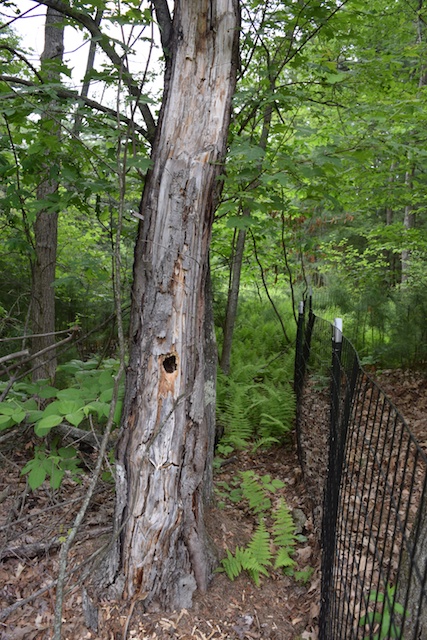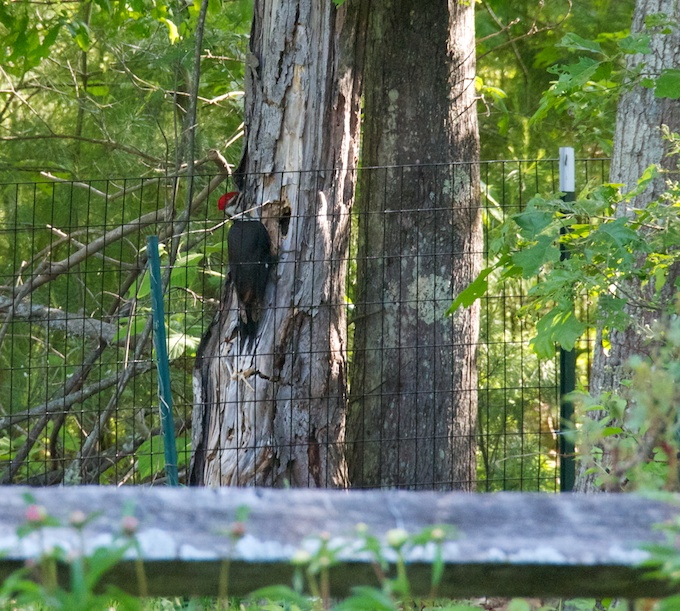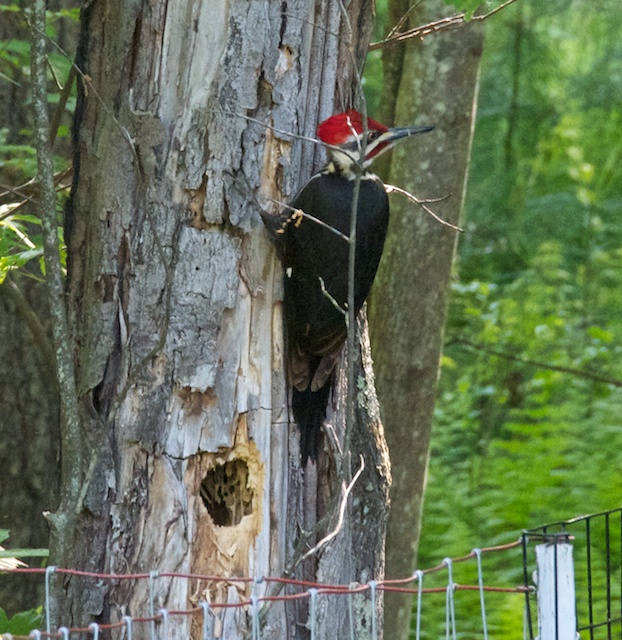I tend to take Lily on walks through the same stretch of woodland.
It never gets boring. It never feels the same. This week the ferns are up and lush. It’s like walking through a prehistoric landscape. As much as I like seeing the green and growing, my favorite things in the woods are the fallen logs. They become old friends, as I watch them change, host moss and lichen, and slowly disintegrate back into the forest.
If I were a textile designer, I could make a career out of creating designs inspired by lichen.
It’s a shame, then, that many homeowners, as soon as they see a tree with damage, call a company to have it removed.
If a tree is hanging over your roof and threatening your home, it should be taken down. But, if the dead wood is in a place where it can fall apart, embrace the mess.
I think that it adds to the texture of the landscape.
Yes, a dead tree hosts insects. Don’t be put off by the ants and creepy crawlies. Those are fodder for birds.
Leave the unsightly tree and you just might find that you have a spectacular visitor.









I agree.
That is a beautiful bird. I have a good friend that a red head woodpecker made quick work of there siding. Drilled a couple holes in every piece from the eave to the foundation on one side of the house.
It was a perfect design too. My friend wasn’t impressed nor was her insurance company. ;-)
Luckily, there’s nothing under the siding of our house for the birds to eat, but they do drill test holes!
What we see as decay is really abundant in life. That is a beautiful bird.
My husband went outside to see what was making a racket under the kitchen window to find a small woodpecker drilling away at our house, unsuccessfully he eventually realized as we have vinyl siding.
One morning I wondered why there was insulation on the ground, looked up and found a hole. Flicker was making a house, boarded it up. the flicker started a number of holes which we boarded up. Finally we decided if it wanted a house, we would give him a house. Spent Easter Sunday building a flicker house, which solved that problem – for a couple years. As soon as they began working on other side of house, we built and put up another flicker house. But now the squirrels want to live in the houses.
I think that flickers are the prettiest birds!
I love moss and lichen. Your picture reminds me of a lovely rainy morning spent at a garden in Japan that specializes in them. The name escapes me at the moment but the vistas, never. Thanks.
You have had the best travels!
My husband’s house had cedar shakes for siding since the 1950’s. At first I didn’t care for it, then it grew on me. Once I decided it was cute, a woodpecker of some sort showed up, pecking for carpenter bees (we assume). So my husband decided it was time for new siding…
“Don’t be put off by the ants and creepy crawlies. Those are fodder for birds.”
Recently I read Bringing Nature Home by Douglas Tallamy. He makes the case that native plants support native insects, which in turn support native birds. Very interesting read, especially for those who enjoy caterpillars.
I love it when I see a pleated woodpecker, which is not very often. That one is spectacular.
Decades ago my father planted a Chinese Magnolia in our backyard which flourished. Each year around New Year’s it was an amazing explosion of pink blossoms–the first thing I would see out my window in the morning. The first thing I would hear would be the chattering of backyard birds in that tree–mourning doves, sparrows, finches, jays–waiting. I never pruned it because with its intricate network of branches it became a safe haven from the menacing hawk who couldn’t penetrate it. Until my father passed away, he’d bring out a token can of birdseed for the tree bird feeders daily. I continued the tradition until the tree sadly died. I kept the tree skeleton there for a very long time in spite of criticism. Its leafless, light gray branches were quite beautiful, and importantly, the birds still came.
Lovely story. Tree skeletons are beautiful.
Suzanne, I was going to mention “Bringing Nature Home” as well! The author (an entomologist) talks about the importance of dead trees to biodiversity–apparently there are insect species that can only live in the very specific environment of rotting wood. He goes into fascinating detail about these insects’ habits, family life, etc. I used to cringe at bugs, but thanks to that book I now find the bugs in my yard almost as entertaining as my chickens!
Now I will have to look for that book.
I was just scrolling up through all your beautiful pictures and there, at the top of the page, was an ad for a tree removal service!
I have no control over the ads. They’re placed there by GoogleAds. Google knows what you’re reading, but often gets the content a bit off kilter!
Another reason to leave dead trees alone is if cut down and it has termites those termites will go looking for new dead wood. That just might be your house!!!!!
What a lovely place. It reminds me of some of the rainforests I have visited here in Australia, except for the woodpecker! What a fascinating bird but it sounds like it can be a problem. When we go on holidays to the mountains we love to see the cockatoos land on the verandah of an evening but they also are a problem for homeowners as they love to chew on wood.
Oh, how I’d love to see wild parrots!
I am one of those silent devotees of your wonderful blog. Anyway, your reflections on the beauty of decaying logs calls to mind the “stumpery” popularized in England by the Victorians. They have been enjoying something of a resurgence recently. I think they are quite beautiful and the perfect feature for a woodland garden.
I had to do a Google search for stumpery. It just calls for alliteration -Stunning stump scapes!